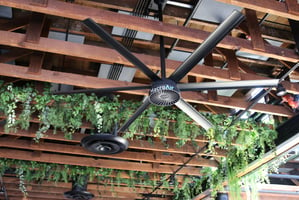Cooling your space efficiently is something you want done right in order to keep your environment...
Key Features to Look for in a Direct Drive HVLS Fan
Direct drive fans represent the ultimate in HVLS fan technology. With a MacroAir direct drive fan, you are getting the very best fan on the market today.
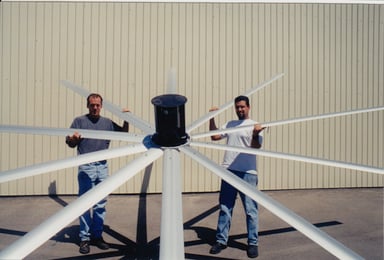
In 1998, the founders of MacroAir, Walt and Eddie Boyd, invented the very first HVLS fan. The company, then, went on to develop the very first direct drive HVLS fan. They truly understand everything HVLS and direct drive. They are fearless innovators who believe in moving air precisely, smoothly, efficiently, and infinitely. A MacroAir direct drive HVLS fan performs superbly, runs quietly, and operates efficiently. In this blog, we will explore these fans in more detail.
Direct Drive Motor
MacroAir’s premium direct drive fans are top-notch, gearless motor fans. Instead of gears used to create torque and move blades like a traditional gearbox fan, direct drive fans use magnets and windings to move the rotor without the use of any gears. Fewer moving parts inside the motor mean less noise, less weight, and less maintenance. Fan motors range between .75-2.0 hp depending on the fan size and model. This equates to unparalleled energy efficiency and superior fan performance.
Performance
At the end of the day, your direct drive fan is designed with one thing in mind – to move some serious air. That is exactly what you get with MacroAir direct drive fans. They move significant air. These fans aren't just about size; they're about precision in air movement. One direct drive fan can effectively cover up to 22,000 square feet. With that coverage, people experience a cooling effect leaving them feeling up to 15°F cooler as they work or play.
Energy Efficiency
.jpg?width=431&height=292&name=Crack%20Shack%201079%20(1).jpg)
HVLS fans have always been a cost-effective way of helping to heat and cool business locations. Direct drive fans only require about 1 hp to run and cost as little as 0.05 cents per hour. This adds up to value you can bank on. Running fans also save you money on traditional AC and heating costs, as those sources do not need to be used as frequently. This extremely efficient operation can save you as much as 30% or more on your overall energy costs. You can recuperate your initial investment in as quickly as six months.
Noise
Direct drive fans cut noise down significantly. Their motors also weigh much less and have zero liquids like oils, eliminating the potential for a leak. They offer less friction for an overall quieter performance. In general, all HVLS fans spin at a much slower rate, therefore they are much quieter than small high-speed fans. When talking at sound level, we measure in decibels (dBA). MacroAir fans range between 33-61 dBAs depending on the fan size and model, whereas smaller high-velocity fans generally range between 50-60 dBAs.
Weight
Direct drive motors are smaller and lighter than gear drive motors. Therefore, they weigh much less. The weight range of a MacroAir direct drive fan is between 71-260 lbs depending on the fan size and model. That includes fans between 6-24 feet in diameter. MacroAir’s anodized aluminum airfoil blades also contribute to the overall lighter weight of the direct drive fans. These anodized blades are unique to MacroAir. The premium finish makes them more durable, rust and corrosion-resistant, and easier to keep clean.
Maintenance
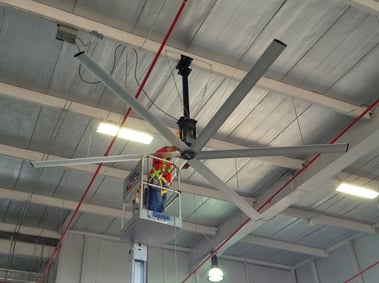
With the direct drive motor, you have fewer moving parts (like gears) which equals less maintenance. Furthermore, most large ceiling fans are made with extruded aluminum. It is recommended that you conduct annual fan maintenance, which is as simple as 1-2-3. This will lead to a longer lifespan on your investment. MacroAir has created a simple fan care card to help with the process. Download your card today by clicking the link below.
Warranty
One of the first things that you should think about when choosing a direct drive fan is the type of warranty provided by the manufacturer. A short warranty is a bad sign during your HVLS fan selection because it means that the fan’s manufacturer does not have as much confidence in its products. A long warranty can save you a significant amount of money over the life of the fan if repairs are needed, which is why a long warranty is a huge benefit when it comes to finding fans with low maintenance and repair costs.
MacroAir direct drive fans come with an industry-leading warranty. Our mechanical warranties vary between 10-15 years, while our electrical warranties range between 5-10 years depending on the fan model.
MacroAir Direct Drive Fans
There are three direct drive fans in the MacroAir product line. A direct drive fan is a fan that uses a series of magnets to move the rotor without the use of gears. These fans are extremely efficient, ultra-quiet, and cost only pennies per day to run. They are great options for warehouses, shops, commercial spaces, gyms, and restaurants. They work great in indoor and outdoor spaces.
AVDX - The Powerhouse
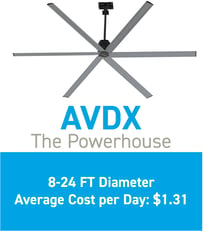
The AVDX is ideal for large spaces in need of major air movement. With 8-24 foot diameters, one fan effectively covers up to 22,000 sq ft at only $0.16 per hour. Its durability and reliability will enhance comfort year-round.
AVD3 - The Showstopper
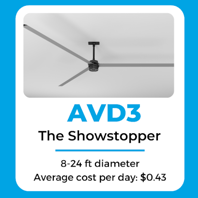
The AVD3 combines powerful airflow with remarkable energy efficiency. With 8-24 foot diameters, the ultra-quiet AVD3 integrates function and style to deliver major cost savings. One fan covers up to 17,000 sq ft at just $0.05 per hour.
AVD370 - The Icon
![]()
The sleek AVD370 has got you covered! This fan offers quiet and powerful air movement to enhance both indoor and outdoor areas alike! Available in 6-12 ft, one fan effectively covers up to 4,000 square feet at only $0.05 per hour.
The Bottom Line
-2.jpg?width=373&height=249&name=Subaru_Sioux_Falls_Garage_AVD3_4%20(1)-2.jpg)
You really can not go wrong with a direct drive fan by MacroAir. By adding one, you can make your facility quieter and more comfortable while reducing your monthly energy costs. We recommend speaking with a fan specialist before you invest to ensure you fully understand the features, benefits, and application of the direct drive fan. They can work to find the very best model and size to fit your specific needs.
